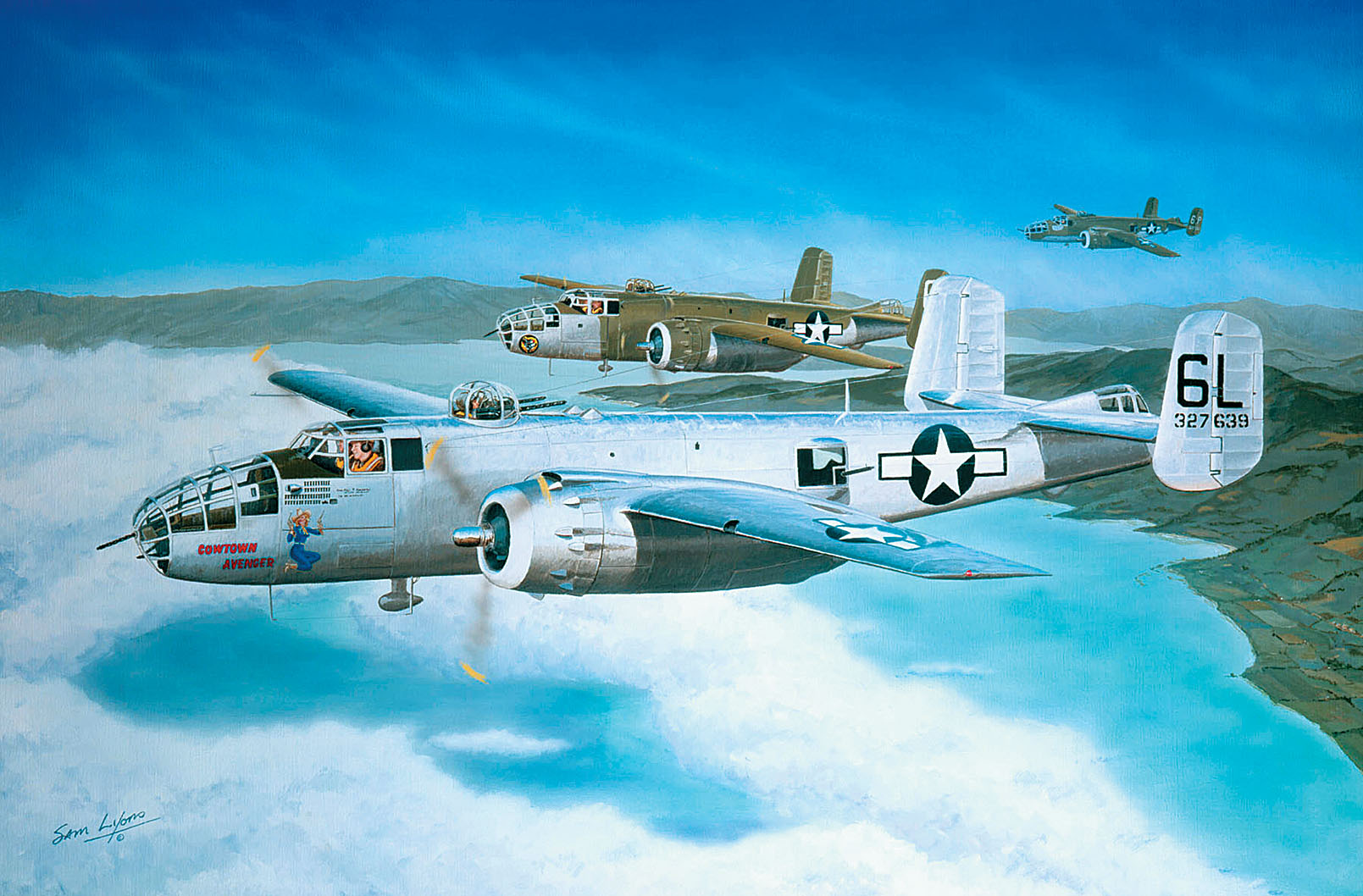Veteran aviation artist Sam Lyons had to carry out some detective work in the course of research for his latest commissioned painting. Return From Rimini depicts a formation of North American B-25J Mitchells from the 386th Bomb Squadron returning to their base on Corsica on September 9, 1944, following an attack on German troop concentrations and heavy anti-aircraft positions in northern Italy. Major Robert McCart Hackney, who led the 48-aircraft raid, received an Oak Leaf Cluster to his Distinguished Flying Cross for the mission. Lyons’ painting was commissioned by Neil Planzer as a gift for his wife, Andrea Nash, niece of the late Major Hackney. Hackney, who flew a total of 55 WWII missions, died in 2001.
As Lyons searched for information on Hackney’s B-25J, Andrea also became involved. They consulted a wide variety of sources about the missions of the 386th Squadron and the 340th Bomb Group. The men and planes moved from base to base as their front lines advanced. As a result, photos were somewhat scarce. The citation accompanying Hackney’s Oak Leaf Cluster contributed one piece of the puzzle. “We know from the citation that his aircraft was hit several times by flak from German guns during the attack near Rimini,” Lyons noted.
Rimini was strategically important to the Germans and the pro-Fascist Repubblica Sociale Italiana (RSI) after the fall of Rome in June 1944. As the Allies pushed north, the German and RSI forces fell back to a line across the top one-third of the peninsula. This heavily fortified Gothic Line ran from La Spezia on the west coast along the ridges of the Apennines to the Adriatic Sea in the east. Most of the rail lines supplying the German forces were routed from Germany across Austria, through the Brenner Pass southward into Italy and to the Gothic Line’s transportation center, Bologna.
Boeing B-17s and Consolidated B-24s from the Fifteenth Air Force, B-25s and Martin B-26s from the Twelfth Air Force and British fighter-bombers from the Desert Air Force attacked bridges, rolling stock, truck convoys and electric power plants all along those fortified positions. The generating stations that supplied power to electric locomotives were of particular interest to the Allies, who believed that without these plants the enemy would be compelled to use steam locomotives, reducing the supplies delivered and lengthening the time they spent en route.
Air cover for those targets was limited to about 50 Messerschmitt Me-109s. But hundreds of German 88mm and 37mm antiaircraft batteries were placed along the Gothic Line and rail routes. The 88mm shells could reach an altitude of 49,000 feet and hit B-24s and B-17s. The 37mm guns had a range of 15,000 feet and were often paired with Italian 75mms that could hit a target at 27,000 feet. Flying at an average of 20-25,000 feet, the B-25s were within reach of the lighter but still deadly weapons. Thus a formidable array of guns greeted Hackney and his men.
Early on, Lyons decided to depict Hackney’s aircraft heading homeward, showing the eight flak hits taken by the lead aircraft. When it came to markings, Lyons uncovered some evidence of a B-25J with “6L” painted on the vertical stabilizer. “There was a 6L [in the squadron], and the serial number matches that 6L but it had no nose art,” he explained. The photo Lyons discovered of that aircraft was dated 1943. Since many pilots were rotated through the squadron at that juncture, and the time frame of the painting was a year later, he decided that 6L might well have been the one Hackney flew. Planzer had requested that Lyons name the B-25 Cowtown Avenger, a reference to Hackney’s hometown of Fort Worth, Texas.
Planzer and Nash have said they view Return to Rimini as “a magnificent reminder of Hackney’s outstanding courage and devotion to duty.” The painting is no less a tribute to Sam Lyons’ skill as an artist than it is to his excellent detective work.
Originally published in the January 2008 issue of Aviation History. To subscribe, click here.





